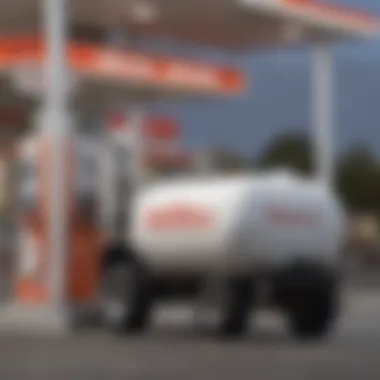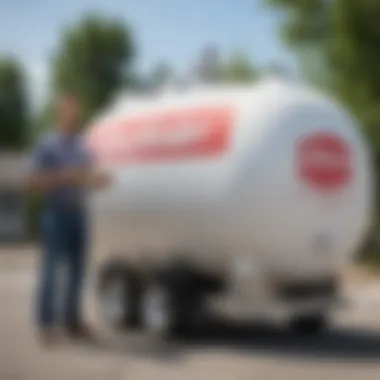Where to Fill Up Propane Tanks: Your Complete Guide


Intro
Navigating the world of propane tank refills can be a daunting task, especially for those unfamiliar with available options and safety practices. Propane is a versatile energy source, often used for outdoor cooking, heating, and even powering appliances. A comprehensive understanding of where to refill these tanks not only increases convenience but also ensures a safe usage experience.
This guide aims to elucidate various locations for propane refilling, including typical options such as gas stations, home improvement stores, and specialized service providers. In addition, it will cover important safety regulations and practical considerations when choosing a refill service. Understanding these factors contributes to more effective and safer solutions for propane tank management.
- Convenience and safety remain utmost considerations while refilling propane tanks.
By the end, readers will have a better grasp of how to efficiently manage their propane needs, ensuring that their outdoor experiences or home appliances function without interruptions.
Key Locations for Propane Refills
Finding the right place to fill up a propane tank involves knowing where to look. Here are some common options:
- Gas Stations: Many gas stations are equipped to handle propane refilling. It is worth checking local stations, especially the larger chains, to see if they offer this service.
- Home Improvement Stores: Stores like Home Depot and Lowe’s usually provide services for propane tank exchanges and refills. This can be a convenient option for many individuals.
- Dedicated Propane Suppliers: Specialized companies such as AmeriGas and Ferrellgas focus specifically on propane. Enlisting their services may offer more additional safety and expertise, making them a valuable choice.
- Mobile Propane Vendors: Some areas have mobile propane filling services which come directly to your home or location to refill your tank, ensuring ultimate convenience.
It’s essential to weigh the options based on distance, ease of access, and costs involved.
Safety Regulations and Considerations
Filling up a propane tank requires adherence to specific safety codes and regulations. Understanding these guidelines is crucial for both personal safety and compliance with local laws.
- Cylinder Standards: Ensure your propane cylinder meets the Department of Transportation regulations. Regular inspections for dents or corrosion are critical.
- Proper Ventilation: When filling propane, the area should be well-ventilated. Never fill tanks indoors.
- Qualified Personnel: Ensure that the refill or exchange is conducted by trained professionals. This minimizes risk and ensures safe extraction procedures are correctly followed.
A careful approach is necessary, as improper handling of propane can result in fire hazards.
Pricing Factors
The cost of propane can vary significantly depending on location, release time, and the type of service utilized. Some factors to consider include:
- Local Market Prices: Prices might vary due to regional demand or supply issues. Checking different providers can result in cost savings.
- Service Fees: Some providers may charge fixed fees or offer discounts for frequent customers. Inspecting what each supplier offers can help devise a better plan financially.
- Tank Size: The size of your propane tank will also dictate the refill price. Generally, larger tanks will lead toward steeper recharge costs but also might provide better value per gallon.
By reviewing these considerations, consumers can better prepare financially for managing their propane needs.
The End
Finding a reliable and effective method for filling up propane tanks necessitates owing attention to the various available locaitons and understanding the safety and pricing factors involved. Armed with this comprehensive assessment, it is feasible for individuals to make informed decisions that enhance their convenience and safety while using propane. From local gas stations to specialized providers, being well-versed will allow for uninterrupted access, making it easier for you to handle your propane requirements.
Proper management of propane helps maintain safety and utility in everyday usage.
Understanding Propane Use
Understanding the utility of propane as a fuel is crucial for anyone who relies on it for various everyday applications. Prominently used for heating, cooking, and even powering vehicles, propane stands out due to its energy efficiency and cleaner burning properties compared to other fossil fuels. This section provides essential knowledge that lays the groundwork for smart decisions related to propane tank refills.
Overview of Propane as a Fuel Source
Propane, a byproduct of natural gas processing and crude oil refining, is a highly versatile energy source. Its key attributes include a high energy content and the power to produce heat quickly. Its efficiency in energy usage makes propane suitable for both residential and commercial applications. Furthermore, when burned, propane emits lower levels of carbon dioxide and particulates than traditional gasoline and wood, cementing its status as a more environmentally-friendly choice. For reliable performance, regular inspections and maintenance of propane tanks are advisable. As it expands, it can increase pressure significantly, affecting comfort levels and cooking results.
Common Uses of Propane
The applications of propane are widespread, contributing significantly to various sectors:
- Residential Heating: Many homes use propane for space heaters, radiators, and furnaces.
- Cooking: Propane is favored for ranging from residential kitchens to commercial diners for its ability to heat evenly.
- Water Heating: Controlling water temperature efficiently in both tank and tankless systems lends propane another practical edge.
- Outdoor Grilling: In the culinary world, outdoor barbecue enthusiasts often choose propane grills for their convenience and clean burn.
- Agricultural Uses: Farmers utilize propane for crop drying and powering farm equipment.
- Transportation Fuel: Many vehicles, especially in fleet applications, utilize propane as an alternative to gasoline or diesel.
In today's energy-centric world, recognizing how propane serves various functions aids not only in enhancing its advantages but also influences choices regarding where to refill tanks and the providers to engage with.
Types of Propane Tanks
Understanding the types of propane tanks is crucial for anyone utilizing propane as a fuel source. The selection of the appropriate tank depends on various factors including intended use, installation site, and overall efficiency. This section outlines key distinctions between tanks.'


Residential vs.
Commercial Tanks
The choice between residential and commercial propane tanks often comes down to the volume of propane required. Residential tanks are generally smaller, accommodating everyday household needs like cooking, heating, and hot water. Typically, these containers range from 120 gallons to 500 gallons.
Conversely, commercial tanks can be significantly larger. These tanks serve businesses that demand larger quantities of propane for operational tasks, such as powering forklifts or ovens in restaurants. Commercial tanks might hold over 1,000 gallons.
When assessing your options, consider the following:
- How much propane will you need?
- Is there enough space on your property for larger tanks?
- Are there specific regulatory requirements for storing propane in your area?
Each type fulfills specific needs, ensuring propane users get appropriate service for their applications.
Portable Tanks vs.
Stationary Tanks
Portable tanks are designed for ease of mobility. Common in outdoor activities like camping or temporarily outdoor cooking, these smaller tanks typically have a capacity of around 20 to 40 pounds. They are light enough to be filled at many easily reachble locations and can be transported easily by individuals.
On the other hand, stationary tanks remain in one place and are often used for residential or commercial applications where more significant propane storage is necessary. These tanks, larger in size, are crucial for facilities that rely heavily on propane for continuous operations. They can accommodate anywhere from 500 gallons to several thousand gallons.
When determining your tank type, consider the following:
- Frequency of use: Propane users who need consistent supply should choose stationary tanks.
- Required capacity: Understand how much fuel you might consume.
- Transport needs: If portability is a factor, portable tanks will suit these circumstances best.
Choosing the suitable propane tank is fundamental for efficiency and performance.
A clear comprehension of the different propane tank types allows users to make informed decisions tailored to their unique usage scenarios. Emphathy for operational needs is paramount.
Where to Fill Up Propane Tanks
Understanding where to fill up propane tanks is essential for individuals who rely on propane for various applications, including cooking, heating, and other activities. Knowing convenient locations can save time and reduce hassle when refills are necessary. Additionally, it allows for better budgeting, as prices may vary among locations, and ensures compliance with safety standards. This section will delve into common locations to refill your propane tank, shedding light on the advantages and considerations of each.
Gas Stations
Gas stations are often the first option many consider when seeking to fill up a propane tank. They provide a convenient option, as these locations are widespread and easily accessible. The service tends to be efficient, allowing you to refuel quickly while on-the-go.
However, not all gas stations provide propane filling services. It is essential to check ahead or look for signs displaying availability. Pricing can also differ from one gas station to another. Convenience is often prioritized at gas stations, but it’s wise to compare prices, particularly if multiple options are available in your area.
Home Improvement Stores
Home improvement stores like Home Depot or Lowe's regularly offer propane filling services. These stores cater to a customer base that frequently requires propane for heating or outdoor cooking equipment. Here, you can typically find knowledgeable staff who can guide you about safe handling and usage of propane.
Additionally, these stores often have customer loyalty programs, providing possible discounts on refills or accessories for propane use. Completing the refill can easily coincide with other home projects, making this a practical choice for many consumers. Some large home improvement retailers even allow for reservation of propane tanks ahead of time, ensuring availability upon your arrival.
Specialty Propane Dealers
For those seeking expertise in propane services, specialty propane dealers present a dedicated option. These establishments focus on propane and related equipment, ensuring that customers receive top-quality service and information.
The benefits of going to specialty dealers include knowledgeable staff who can address specific inquiries regarding tank size, gas appliances, and local safety regulations. Moreover, these dealers may offer additional services, including delivery options, equipment sales, or maintenance, that may not be available at other types of refill locations. While they might charge higher prices, the added value of specialized service can justify the cost.
Grocery Stores and Retail Chains
A growing number of grocery stores and retail chains are now providing propane refilling facilities. Establishments such as Walmart and other large supermarkets may include park-and-fill options for customers seeking convenience.
This multifaceted approach means you can attend to necessary weekly errands while simultaneously ensuring your propane tanks are refilled. It enhances the convenience factor, particularly for busy families or individuals. Always verify that certain grocery stores participate in propane filling services, as not all branches may donate this.
Propane Exchange Locations
Propane exchange locations offer yet another convenience for individual consumers. These setups often involve a quick swap-out method where empty tanks can be exchanged for full ones without needing to be refilled on-site.


Many convenience stores, large retailers, and even some gas stations have propane exchange programs that allow you to deposit your empty tank and instantly receive a full replacement. This method can save significant time, making it an attractive choice for folks who need a refill quickly without the intricacies involved in refilling themselves.
Exchanges often charge a flat fee, providing a predictable cost structure. Be aware of various brands of tanks, as some locations may require specific measurements for safe use.
Factors to Consider When Choosing a Propane Fill-Up Location
Selecting the proper location to refill your propane tanks is critical for a number of reasons. Efficiency, prices, and safety all play a vital role in the process. The strategic choice of fill-up locations can save you time and money, enhancing your overall experience with this essential fuel source. In this section, we’ll delve into specific elements that should guide your decision-making when looking for a propane supplier.
Pricing Variations
Understanding pricing variations is paramount when refilling propane tanks. Prices can fluctuate among retailers, often influenced by a range of factors including location, demand, and purchasing power.
When evaluating prices, consider these aspects:
- Market Trends: Keep an eye on local pricing trends. Seasonal changes may lead to price increases, especially during peak usage periods.
- Promotions: Some retail locations or suppliers may offer discounts or loyalty programs. Always be on the lookout for these opportunities to reduce costs.
- Nearby Options: Comparing prices between gas stations, home improvement stores, and specialized vendors can lead to savings.
Use the internet to research the best local prices. This may involve checking resources like en.wikipedia.org for regional averages or forums like reddit.com where users might share their recent experiences.
Convenience and Accessibility
Convenience and accessibility are key factors that should not be underestimated. It is essential to locate a fill-up station that fits seamlessly into your routine. Here are several points to consider:
- Proximity: The closer the refill station is to your home, the more convenient it will be for regular refills. Long drives just for propane can be counterproductive.
- Operating Hours: Look for locations that have extended hours or 24/7 service. This ensures flexibility in case you need to refill outside of traditional business hours.
- Service Quality: A location that is known for having helpful staff can greatly improve your experience. Fast and effective service minimizes wait times, which is particularly crucial when you are in a hurry.
Accessibility can make a significant difference. For those who are physically impaired or have larger tanks, it might be wise to select places that feature proper facilities for easier handling.
Safety Measures and Regulations
Prioritizing safety measures and familiarity with regulations is not just prudent; it is essential. This is especially true in scenarios involving the handling of flammable materials like propane. Critical factors include:
- Local Regulations: Understanding local laws regarding propane storage and refilling can help ensure compliance and safety.
- Equipment Standards: Select fill-up stations that adhere to established safety standards. Properly maintained equipment mitigates potential hazards effectively.
- Emergency Procedures: Check if the location has visible emergency procedures posted. This demonstrates preparedness in the event of accidents or emergencies.
Safety inspections and certified personnel are non-negotiable aspects while choosing a refill option.
Taking time to educate yourself on these factors ensures that not only will you find a convenient option but also will have a safer experience every time you refill your propane tanks.
Tips for Safe Propane Tank Refilling
Filling your propane tank is a necessary process whether you're using it for your grill, heating, or powering appliances. However, it comes with responsibility and potential hazards. Ensuring safe refilling practices is crucial not just for your safety but also for the wellbeing of those around you.
Inspection Before Filling
Before taking your propane tank for a refill, conduct a thorough inspection. Performing this check is vital to identify any potential issues.
- Look for signs of rust or dents.
- Check all connections for leaks or cracks.
- Ensure the safety relief valve is functioning correctly to prevent pressure buildup.
Beyond Visual Checks: It is also a good routine to weigh the tank if possible. An underweight tank might indicate a leak. A propane tank's capacity in pounds tells you how much propane it should hold. If there is discrepancy, it’s better to reconsider the tank's condition.
Proper Handling Procedures
Handling propane tanks properly can significantly reduce risks involved in the filling process. Following strict guidelines can help ensure safety against fire hazards or leaks.
- Always keep tanks upright: This minimizes gas escaping from the relief valve in case of overpressurization.
- Transport with care: Avoid tossing or dropping your tank. Damage may not be visually evident but could compromise tank safety.
- Follow facility instructions: Each filling location has unique protocols. Make sure to comply with them to ensure safe handling.
“The underlying principle of safety in propane management is simplicity—maintaining focus is key.”
Culmination
Maintaining Your Propane Tank


Maintaining your propane tank is crucial not only for its longevity but also for ensuring safety and efficiency in usage. Understanding the proper care and inspection procedures can prevent accidents and ensure that your propane supply is reliable. Neglecting maintenance can lead to hazardous situations, decreased performance, and increased costs.
Understanding Tank Lifespan
The lifespan of a propane tank is generally determined by its construction material and the environment where it is installed. Most standard steel tanks last about 30 years before needing replacement, while composite tanks can have different lifespans based on their specific guidelines.
Periodic inspection by trained professionals is vital. They can check for factors such as corrosion, rust, or any signs of physical damage. According to regulations, tanks must be visually inspected yearly. Having a routine maintenance plan ensures early detection of potential issues. Furthermore, keeping the tank properly painted can prevent rust and maladjustments to the outer Layer’s integrity. Additionally, remember that a tank with satisfactory maintenance can function at optimal levels, maximizing the benefit from every propane fill-up.
Signs of Wear and Damage
Identifying signs of wear and damage on a propane tank is key to maintaining safe operations. Always conduct a thorough visual inspection of your tank. Look for the following:
- Rust and Corrosion: These signs are among the most hazardous for a tank. Corrosion beyond minor surface rash can weaken the structural integrity.
- Leaks: Use soapy water to check for bubbles on connections and joints, which may indicate a gas leak.
- Dents and Scratches: Significant impacts can compromise the tank's structure. A deep dent or scratch should be reported for immediate professional evaluation.
- Discoloration: Unusual discoloration can be indicative of underlying issues.
Regular vigilance can save lives. Always trust and contact professionals for comprehensive evaluations whenever you note anomalies.
Maintaining a functional propane tank involves understanding its lifespan and being alert to any symptoms of wear. Proper upkeep leads to cost savings, increased safety, and reliable performance, all of which are critical in making the most out of your propane supply.
Choosing the Right Propane Supplier
Selecting the correct propane supplier is crucial for individuals who rely on propane for heating, cooking, or other purposes. This choice can affect not only the cost but also the quality of service experienced over time. It’s vital to consider several factors that determine the effectiveness and reliability of the supplier. A great supplier will ensure not just efficient service, but a partnership that can adapt to changing needs.
Evaluating Customer Service
Customer service plays a pivotal role in the relationship between the consumer and the supplier. An attentive propane provider interested in ensuring their customers are satisfied can make a significant difference in service reliability. Customers should gauge the responsiveness of the supplier by asking important questions during interaction, such as how quickly they can address emergencies or service requests.
Good customer service is dynamic and can include:
- Availability: Can the supplier provide assistance in urgent situations?
- Communication: Is their support readily accessible and friendly?
- Transparent Policies: Do they offer clarity on issues such as pricing, safety, and procedural regulations?
One effective approach is to check online reviews and talk to current users about their experience. Trust, based on consistent engagement, leads to better confidence in the supply chain.
Understanding Delivery Options
Delivery options extend the ease of accessing propane without needing to travel long distances or wait for refills. A reliable propane supplier should offer flexible solutions tailored to each client’s situation. Understanding how propane delivery works is essential, particularly for those who prioritize being resourceful with their fuel source.
Key considerations regarding delivery options include:
- Scheduled Deliveries: Predictable delivery dates can alleviate uncertainty and ensure continuous supply. Suppliers may offer monthly or bi-monthly options.
- On-Demand Services: These services cater to emergency needs or for individuals who use propane less consistently. While this option offers flexibility, pricing might fluctuate.
- Bulk Deliveries: For customers with high propane needs, bulk deliveries might be economical and energy-efficient.
Connecting with suppliers can help to draw clarity on what each option entails. Also, commitment to environmental standards is becoming a critical step - inquire if the supplier engages in sustainable practices or using greener delivery methods.
At the end, making an informed choice ensures peace of mind and promotes a more sustainable approach to propane use.
Environmental Considerations in Propane Use
Understanding environmental implications of propane use is crucial, especially in a time where sustainability is a priority for many individuals. Propane, being a clean-burning fossil fuel, often surfaces in discussions surrounding energy sources due to its reduced environmental footprint compared to other hydrocarbons such as gasoline or diesel. These factors must be integrated into one's choices when seeking where to fill propane tanks.
Comparative Emissions
Propane burns more cleanly than numerous other fossil fuels. Its combustion produces significantly lower carbon dioxide emissions. For example, when burned, propane emits about 24% less carbon dioxide than heating oil and approximately 12% less than coal. Considering that the energy industry contributes notably to greenhouse gas emissions, using propane can positively impact the environment by lowering one's carbon footprint. Furthermore, it generates fewer particulates, surpassing natural gas in environmental safety.
Propane as a fuel source is commonly regarded as environmentally friendly due to its fairly low emissions when compared to traditional diesel or coal sources.
While propane presents advantages, it is imperative to consider controlled usage and installation in high-efficiency designs for the hot water systems, car engines, or even in RVs. All of these applications maximize propane's benefits while minimizing the permutations of waste gasses that could lead to pollution.
Regulations and Compliance
Adhering to federal and state regulations regarding propane sales and use is necessary to bolster enhanced environmental stewardship. Departments responsible for regulating propane include the U.S. Department of Transportation and the Environmental Protection Agency. Compliance with these regulations ensures that propane is dispensed responsibly. It also prevents overfilling, which can result in leaks—potentially leading to land or air contamination.
Ensuring that facilities managing propane filling adhere to relevant regulations also protects communities. This includes regular inspections and certifications of storage sites and transportation methods.
Key Points of Regulations:
- Storage: Tanks must be accurately secured and stored away from sources of ignition.
- Handling: Personnel must undergo proper training for handling propane to mitigate risks associated with spills or leaks.
- Reporting: Operators are liable for reporting incidents that harm the environment and endanger the public health.
In summary, considering the environmental aspects associated with propane not only aids in reducing individual carbon footprints but also fosters a cleaner and safer atmosphere through adhering to regulations. This awareness and responsibility shape future energy usage trends.







